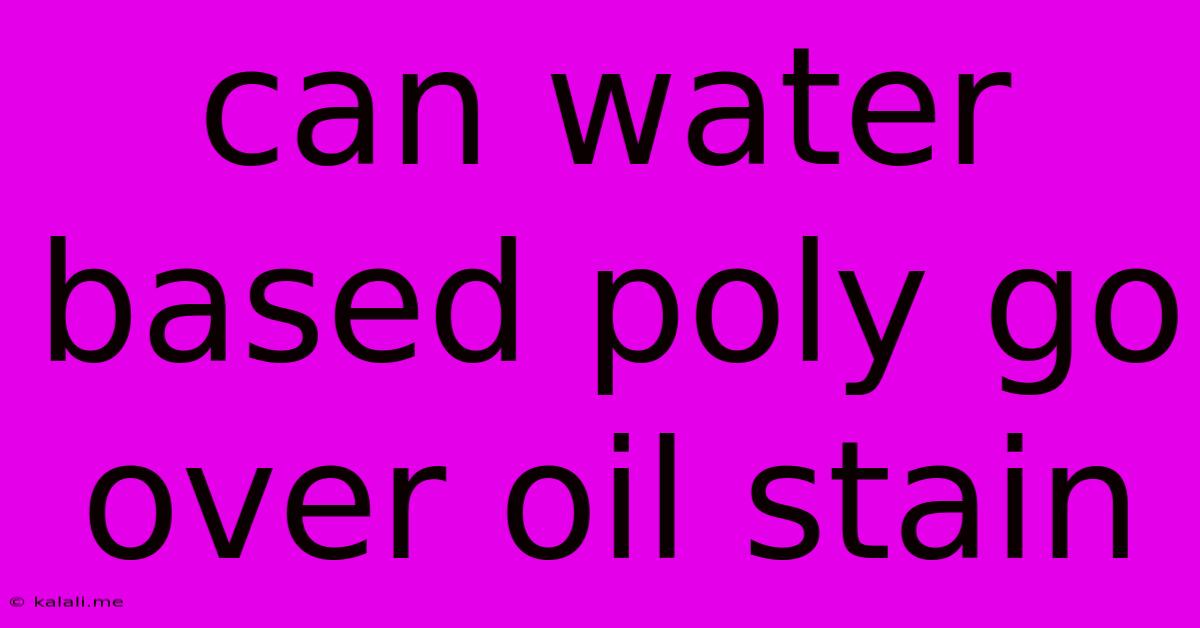Can Water Based Poly Go Over Oil Stain
Kalali
Jun 04, 2025 · 3 min read

Table of Contents
Can Water-Based Polyurethane Go Over Oil-Based Stains? The Definitive Guide
Meta Description: Wondering if you can apply water-based polyurethane over oil-based stains? This comprehensive guide explores the compatibility, potential problems, and best practices for achieving a durable and beautiful finish. Learn about preparation, primer options, and troubleshooting tips.
Applying a finish to your woodworking project is a crucial step, often the difference between a beautiful piece and a disappointing one. A common question among DIYers revolves around the compatibility of water-based polyurethane with oil-based stains. The short answer is: generally, no, not directly. However, with proper preparation, it's possible to achieve a successful finish. This article delves into the reasons why, the necessary steps, and potential pitfalls to avoid.
Understanding the Chemistry: Why It's Problematic
Water-based polyurethane and oil-based stains have fundamentally different chemical compositions. Oil-based stains are, as the name suggests, oil-based. They penetrate the wood, creating a rich, deep color. Water-based polyurethane, on the other hand, is a water-based polymer that sits on top of the wood, creating a protective layer.
The problem arises from the incompatibility of these two substances. Applying water-based poly directly over an oil-based stain can lead to several issues:
- Poor Adhesion: The water in the polyurethane can cause the oil-based stain to lift or become gummy, resulting in a weak bond between the stain and the finish. This leads to peeling, chipping, and an uneven appearance.
- Blooming: The water in the polyurethane can react with the oil in the stain, causing the finish to appear cloudy or milky. This unsightly blooming significantly detracts from the overall aesthetic.
- Lack of Durability: A poor bond will result in a less durable finish. Your project won't withstand the wear and tear it should.
Preparing for Success: Essential Steps
While applying water-based polyurethane directly over oil-based stains isn't recommended, you can still achieve a successful finish with the right preparation. The key is to create a barrier between the two incompatible substances. This usually involves the use of a suitable primer or sealer.
1. Thorough Cleaning: Start by ensuring the surface is clean and free from any dust, debris, or old finishes. Use a tack cloth to remove any loose particles.
2. Sanding: Lightly sand the stained wood with fine-grit sandpaper (around 220-grit) to create a slightly rough surface for better adhesion. This step is crucial for both the stain and the primer/sealer to properly bond with the wood.
3. Primer Application: This is the most crucial step. Apply a high-quality oil-based primer or shellac-based sealer. These primers are designed to provide a barrier between the oil-based stain and the water-based polyurethane. Allow the primer to dry completely according to the manufacturer's instructions. Proper drying time is essential to avoid issues.
4. Light Sanding (Optional): After the primer dries, you may lightly sand it with very fine-grit sandpaper (320-grit or higher) to create a smoother surface. This is optional, but it can help achieve an even finish.
5. Applying Water-Based Polyurethane: Once the primer is completely dry and sanded (if necessary), you can finally apply your water-based polyurethane. Follow the manufacturer's instructions for application and drying times. Multiple thin coats are generally better than one thick coat.
Troubleshooting and Prevention
Even with proper preparation, problems can still occur. Here's how to troubleshoot some common issues:
- Blooming: If blooming occurs, you may need to lightly sand the affected area and reapply the polyurethane.
- Peeling: Peeling indicates a lack of adhesion. This usually means the primer wasn't properly applied or the wood wasn't adequately prepared. You may need to strip the finish and start again.
By following these steps and understanding the chemical interactions between oil-based stains and water-based polyurethane, you can significantly increase the chances of a successful and long-lasting finish on your woodworking projects. Remember, patience and attention to detail are key to achieving professional-looking results.
Latest Posts
Latest Posts
-
How To Get Icloud To Only Save Favorite Photos
Jun 06, 2025
-
How Many Combinations With 9 Numbers
Jun 06, 2025
-
Is The Black Wire Positive Or Negative
Jun 06, 2025
-
Bathtub Drain Lever Wont Go Down
Jun 06, 2025
-
How To Change A Lightbulb On A High Ceiling
Jun 06, 2025
Related Post
Thank you for visiting our website which covers about Can Water Based Poly Go Over Oil Stain . We hope the information provided has been useful to you. Feel free to contact us if you have any questions or need further assistance. See you next time and don't miss to bookmark.